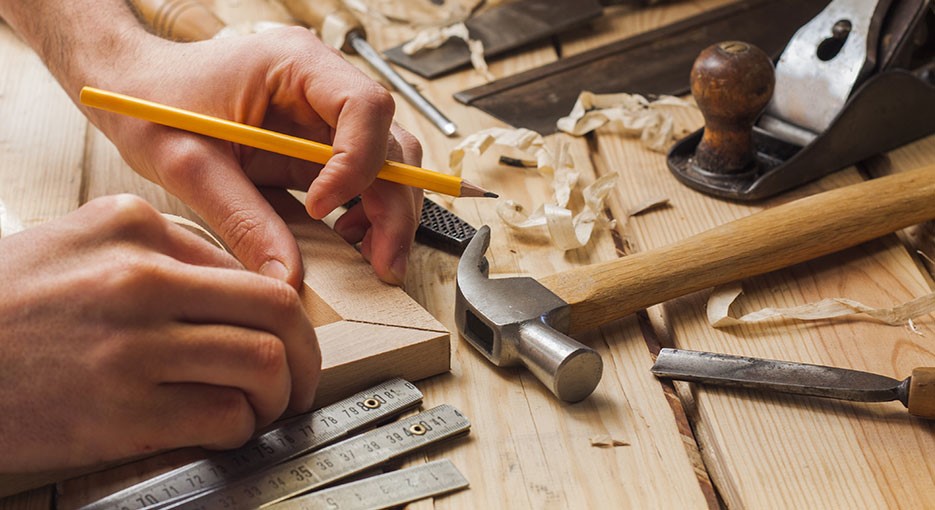Woodworking, which is often linked to creativity and craftsmanship, has become a surprise means of fostering calmness and mental well-being. Imagine being completely engrossed in the rhythmic sound of a saw cutting through a piece of wood, feeling the grain’s smoothness beneath your hands, and seeing the development of your own creation.
This is woodworking, a creative endeavor that offers a mindful practice that has major positive effects on mental health in addition to the physical act of creation.
There has been a notable increase in interest in recent years about mindful exercises and their potential to enhance mental well-being. People are looking for methods to get away from the fast-paced, technologically-driven environment and find comfort in routines that promote inner peace and concentration. With its focus on being completely present in the moment, mindfulness has been hailed for its capacity to lower stress, boost self-awareness, and promote mental toughness in general.
Among the many mindful activities accessible, woodworking stands out as a distinctive and alluring choice. It not only enables you to express your ideas, but it also offers a satisfying and concrete experience. By focusing on the act of making something with your hands and finding peace in the sawdust-filled air, woodworking may provide a break from the stress of daily life. This blog will explore the depths of woodworking as a mindful activity, examining its advantages for mental health and pointing you in the direction of memorable experiences that include both travel and the craft of woodworking.
Understanding Woodworking as a Mindful Practice
Because of its beneficial effects on mental health, mindfulness, which has roots in ancient traditions like Buddhism, has received a great deal of attention in modern culture. Being completely present in the moment while monitoring thoughts and feelings without judgment or attachment is the essence of mindfulness. People who engage in this technique might become more conscious of both their internal and exterior experiences, which enhances clarity, calmness, and wellbeing.
How woodworking aligns with mindfulness principles
The intensive and hands-on nature of woodworking readily fits with the concepts of mindfulness. Here are some examples of how mindfulness is embodied in woodworking:
- Focusing on the present moment: Working with wood needs focus and close attention to the job at hand. Each task, whether it be measuring, cutting, or sanding, requires your whole focus, bringing you into the here-and-now and allowing you to put distracting ideas to rest.
- Cultivating patience and concentration: Woodworking tasks sometimes need for precise and detailed labor. Patience and the capacity for sustained attention are required for this. Woodworking cultivates a sense of flow—an engrossing and profoundly satisfying experience—by perfecting these attributes.
- Encouraging creativity and self-expression: An outlet for creativity and individual expression is provided by woodworking. It provides a platform for creative exploration and self-discovery by enabling you to convert basic materials into distinctive and significant works of art.
The therapeutic aspects of woodworking
Beyond being a simple pastime or craft, woodworking has significant therapeutic benefits for mental health. Here are a few benefits of woodworking as a form of therapy:
- Physical engagement and the tactile experience of working with wood: Woodworking requires a lot of physical exertion. Shape-making with wood encourages a grounded connection with the material and facilitates the release of stress or pent-up energy. Handling various kinds of wood and tools may provide calming tactile sensations, adding to the whole sensory experience.
- Creating something tangible and experiencing a sense of accomplishment: When you deal with wood, you can see your efforts come to life as physical objects. Whether it’s a homemade bowl, a piece of furniture, or a decorative item, finishing a job gives one a great feeling of pride. This observable result may increase self-esteem and help one feel good about themselves.
- Finding joy in the process rather than the end result: The process itself is valued in woodworking, rather than just the result. Immersing yourself in the process of woodworking teaches you to enjoy every minute and find pleasure in the creation process. Woodworking’s methodical and slow pace fosters awareness and the habit of relishing the trip rather of focusing just on the end goal.
With its mix of therapeutic advantages and mindfulness concepts, woodworking provides a unique and rewarding route to tranquility and enhanced mental health.
Exploring the Benefits of Woodworking for Mental Health
A. Stress reduction and relaxation
- Providing a break from the fast-paced modern world: You may unplug from the endless pressures and diversions of contemporary life by taking up woodworking. It gives a much-needed break and an escape into a world of artistry and serenity. Woodworking may have a soothing effect, relaxing the mind and lowering tension because to its rhythmic movements and repeated tasks.
- Channeling negative emotions into productive and creative energy: An effective way to express and alter bad feelings is via woodworking. You may channel your tension, worry, or anger into making something beautiful and important rather than focusing on it. The process of changing unfinished materials into completed products enables emotional release and the development of a more optimistic outlook.
B. Improved focus and concentration
- Developing attention skills through precise measurements and intricate details: Precision and attention to detail are necessary for woodworking. Focus and attention are needed to accurately measure and cut the wood, assemble the components, and pay attention to little details. By doing these activities, you improve your capacity for sustained attention and sharpen your degree of concentration.
- Clearing the mind of distractions and enhancing mental clarity: With its physicality and engaging nature, woodworking might help you clear your mind of clutter. Your mind instinctively tunes out outside distractions as you get fully immersed in the woodworking process and experience a state of flow. You may maintain mental clarity while in this intensely focused state, which aids in finding inner calm and centering.
C. Enhanced self-esteem and confidence
- Overcoming challenges and acquiring new skills: There are several difficulties in woodworking that need problem-solving and skill improvement. You develop a feeling of success and resilience as you learn from and conquer these difficulties. Gaining new carpentry abilities and being able to see your development generates a feeling of self-confidence that goes beyond the actual craft.
- Gaining a sense of pride and accomplishment from completed projects: It can be really satisfying to see a woodworking project through to completion and to see how raw materials are transformed into a completed product. Making something physical, whether it be utilitarian or ornamental, may increase self-confidence and bring about a long-lasting feeling of satisfaction.
D. Emotional well-being and mindfulness
- Promoting a state of calm and tranquility: The methodical and leisurely pace of woodworking encourages peace and quiet. Activities involving woodworking may promote emotional regulation, anxiety reduction, and a serene frame of mind. The attention and repeated movements necessary for woodworking may lead to a meditative state that encourages calmness and inner serenity.
- Fostering self-reflection and self-awareness: Woodworking gives one the chance to ponder on and become more aware of oneself. You could become more aware of your thoughts, feelings, and physical sensations while you work with the wood. This increased self-awareness promotes a better knowledge of who you are, which may help you develop personally and feel better in general.
You may enjoy all of these advantages by using woodworking as a mindful practice, improving your mental health and general wellbeing in a positive and gratifying way.
Where to Experience Woodworking as a Mindful Practice
A. Highlighting workshops and classes
- Local community centers and adult education programs: For both novices and seasoned woodworkers, a number of neighborhood community centers offer seminars and lessons in the craft. These seminars provide a welcoming and inclusive atmosphere where you may pick up woodworking skills, utilize specialist equipment, and interact with local woodworkers.
- Specialized woodworking schools and studios: Specialized woodworking schools and studios provide extensive courses taught by experienced craftsmen for a more in-depth understanding of the art. These institutions provide defined courses, practical instruction, and access to high-quality tools. You may thoroughly immerse yourself in the craft of woodworking and get professional advice by enrolling in such organizations.
B. Showcasing retreats and immersive experiences
- Forest retreats that combine nature and woodworking: Imagine studying carpentry skills while surrounded by the tranquility of a forest. Forest retreats provide a special environment where you may practice mindful carpentry among the peace of nature. These retreats often provide guided sessions, seminars, and the chance to meet others who share your enthusiasm for the outdoors and woodworking.
- Retreat centers offering mindfulness-based woodworking programs: Some retreat places put up programs that combine mindfulness techniques with woodworking. Along with woodworking lessons, these retreats include meditative, mindful, and movement techniques. These workshops provide a comprehensive approach to mental health and self-discovery by fusing mindfulness with carpentry.
There are many ways to investigate woodworking as a mindful practice, regardless of your preference for a local group environment or your need for a more intensive experience. You may expand your knowledge of woodworking skills, meet other enthusiasts, and start a journey of self-discovery via the craft by taking part in courses, classes, or retreats.
Inspiring Woodworking Destinations Around the World
A. Exploring traditional woodworking cultures
- Japan: Japan provides a long history of woodworking and is renowned for its exquisite workmanship and attention to detail. Japanese joinery displays the skill and accuracy of ancient Japanese woodworking methods and is distinguished by elaborate interlocking connections without the use of nails or screws. You may see firsthand the craftsmanship and expertise that have been handed down through the years by visiting woodworking workshops and museums in places like Kyoto and Tokyo.
- Scandinavia: Scandinavian design is recognized for being utilitarian and simple, and carpentry is a big part of this style. Nordic woodworking traditions place a strong emphasis on natural materials and simple designs. It is possible to appreciate the simplicity and beauty of Scandinavian workmanship, from traditional furniture manufacturing to the art of woodcarving, by investigating woodworking communities in nations like Sweden and Norway.
B. Uncovering unique woodworking communities
- Oregon, USA: Woodworking, among other forms of creativity and skill, is well-known in Portland, Oregon. There are several artisanal woodworkers, workshops, and collectives in the city, which has a thriving woodworking culture. You can see how ancient methods and cutting-edge ideas are combined in Portland’s woodworking scene, with an emphasis on sustainable practices and the use of local resources.
- Bali, Indonesia: The beautiful, tropical scenery of Bali serves as an ideal setting for woodworkers. The island is renowned for its talented woodcarvers, who produce elaborate furniture, sculptures, and ornaments. It is possible to see the blending of traditional Balinese skills with contemporary designs by seeing Bali’s art villages and woodworking studios. The woodworking experience is enhanced by being fully immersed in Bali’s lively culture and breathtaking scenery.
These locations provide one-of-a-kind chances to investigate various woodworking traditions and interact with regional craftspeople who have polished their trade over many years. Each site offers an immersive experience that embraces the beauty of carpentry and its cultural relevance, whether you are attracted to the precision of Japanese joinery, the simplicity of Scandinavian design, the ingenuity in Portland, or the craftsmanship in Bali.
Tips for Getting Started with Woodworking as a Mindful Practice
A. Emphasizing the accessibility of woodworking for beginners
- Starting with simple projects and gradually progressing: Starting with simple assignments that are appropriate for your ability level is crucial for beginners. Pick tasks that need just a few simple tools and skills. Challenge yourself with increasingly difficult tasks as your confidence and expertise grow. You may develop your talents while having fun with this methodical technique.
- Learning from online tutorials and resources: There are many resources available online to learn woodworking. Woodworking forums, online courses, and video demonstrations all provide helpful direction and training. Woodworking-specific websites and YouTube channels often provide a variety of methods, safety advice, and project ideas. Utilizing these resources enables you to pick up knowledge from seasoned woodworkers while studying at your own speed.
B. Recommending essential tools and materials for beginners
- Basic hand tools for woodworking: You’ll need a few basic hand tools to get started. These tools consist of a crosscut saw, coping saw, various-sized chisels, a mallet, a block plane, a tape measure, a combination square, and a pair of screwdrivers. You may accomplish basic woodworking activities including cutting, shaping, and connecting wood with the help of these tools.
- Selecting suitable types of wood for different projects: It’s important to choose the correct kind of wood for woodworking tasks. Softwoods like pine or spruce are simpler to work with and more forgiving as a novice, so you could think about using them. These woods are reasonably priced and easily accessible. As you develop expertise, you may investigate hardwoods with a lovely finish, such as oak, maple, or walnut, which provide increased durability. It’s critical to choose wood that meets the demands of your project in terms of sturdiness, aesthetics, and workability.
Beginners may start their woodworking career with confidence by paying attention to these suggestions. The basis for a rewarding and fun woodworking experience is laid by starting small, using internet information, and investing in the required equipment and supplies. Remember that gaining new skills and expressing your creativity are important parts of the lifelong learning process that is woodworking.
Wrapping up
A special and rewarding approach to foster calm and mental well-being is via woodworking. Woodworking encourages people to express their creativity, acquire patience and attention, and concentrate on the now via its congruence with mindfulness ideals. The physical involvement, concrete results, and concentration on the process that go along with woodworking’s therapeutic benefits help to reduce stress and increase focus while also boosting self-esteem and emotional well-being.
Woodworking is a worthwhile endeavor to investigate if you’re looking for a mindful activity that combines creativity, skill, and mental well-being. Being mindfully involved in woodworking may be a transformational and fulfilling experience. The act of working with wood has the ability to improve your mental health, stimulate self-expression, and open you a world of creativity, whether you start with simple tasks or go for full retreats. Take advantage of the chance to set out on this adventure and learn for yourself how soothing woodworking can be.
Keep in mind the advice of famous author and carpenter George Nakashima as you begin your woodworking journey: “The tree lives on in the wood and in the product that is produced from wood. The peace and strength of the sculpture stem from the unity of the tree and the wood. The profundity of the relationship between woodworking, mindfulness, and the creation of works of art from simple materials is well captured in this remark. So while you explore the world of woodworking as a mindful practice, let the sawdust lead you to calm, creativity, and a restored feeling of wellbeing.








Leave a Reply
You must be logged in to post a comment.